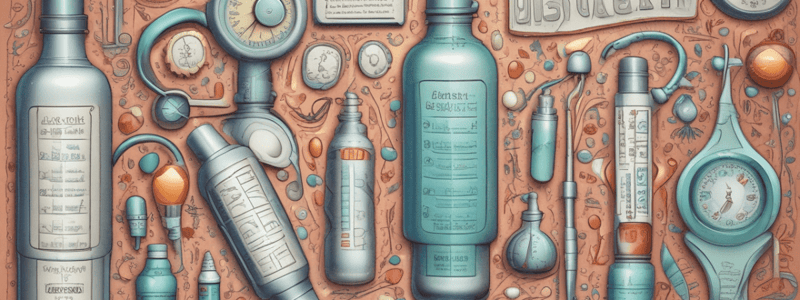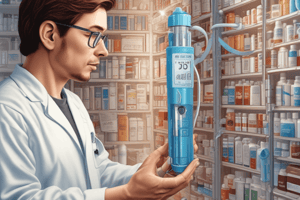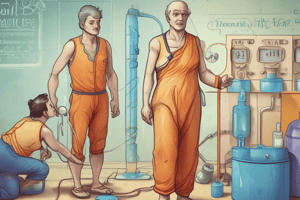Podcast
Questions and Answers
What is the primary benefit of using GLP-1 agonists or its similar contraindications?
What is the primary benefit of using GLP-1 agonists or its similar contraindications?
- Moderate A1c reduction (correct)
- Improving beta-cell function
- Reducing hypoglycemia
- Increasing insulin sensitivity
What is a common side effect of GLP-1 agonists and its similar contraindications?
What is a common side effect of GLP-1 agonists and its similar contraindications?
- Hypertension
- Weight gain
- Hypoglycemia (correct)
- Hyperglycemia
Which of the following is NOT a benefit of using GLP-1 agonists or its similar contraindications?
Which of the following is NOT a benefit of using GLP-1 agonists or its similar contraindications?
- Increased glucagon secretion (correct)
- Improved insulin sensitivity
- Weight loss
- Reduced cardiovascular risk
What is the primary mechanism of action of GLP-1 agonists and its similar contraindications?
What is the primary mechanism of action of GLP-1 agonists and its similar contraindications?
Which of the following insulin types is NOT similar to GLP-1 agonists?
Which of the following insulin types is NOT similar to GLP-1 agonists?
Which type of insulin regimen involves the use of multiple daily injections?
Which type of insulin regimen involves the use of multiple daily injections?
What is the hormone that is released into the bloodstream along with insulin after a meal?
What is the hormone that is released into the bloodstream along with insulin after a meal?
Which type of insulin therapy is no longer mentioned in the content?
Which type of insulin therapy is no longer mentioned in the content?
What is Pramlintide an analogue of?
What is Pramlintide an analogue of?
What is absent in individuals with Type I diabetes?
What is absent in individuals with Type I diabetes?
At what GFR are loop diuretics less effective?
At what GFR are loop diuretics less effective?
What is the only agent currently approved for the treatment of T2D?
What is the only agent currently approved for the treatment of T2D?
What is the name of the class of noninsulin injectable agents?
What is the name of the class of noninsulin injectable agents?
Which of the following agents is not a GLP-1 Agonist?
Which of the following agents is not a GLP-1 Agonist?
What is the potential side effect of concomitant diuretic use?
What is the potential side effect of concomitant diuretic use?
Concomitant diuretic use may cause hyperglycemia and electrolyte abnormalities.
Concomitant diuretic use may cause hyperglycemia and electrolyte abnormalities.
Loop diuretics are less effective at a GFR of 60-75 ml/min/1.73m2.
Loop diuretics are less effective at a GFR of 60-75 ml/min/1.73m2.
Tirzepatide is the only agent approved for treatment of Type 1 diabetes.
Tirzepatide is the only agent approved for treatment of Type 1 diabetes.
Albiglutide is a DPP-4 inhibitor.
Albiglutide is a DPP-4 inhibitor.
Liraglutide is an insulin sensitizer.
Liraglutide is an insulin sensitizer.
SGLT-2 inhibitors reduce glucose reabsorption in the distal nephron.
SGLT-2 inhibitors reduce glucose reabsorption in the distal nephron.
SGLT-2 inhibitors increase urinary glucose excretion by up to 90 g/day.
SGLT-2 inhibitors increase urinary glucose excretion by up to 90 g/day.
SGLT-2 inhibitors work by stimulating the production of insulin.
SGLT-2 inhibitors work by stimulating the production of insulin.
SGLT-2 inhibitors are a type of insulin sensitizer.
SGLT-2 inhibitors are a type of insulin sensitizer.
Sodium-glucose co-transporter 2 inhibitors are used to treat type 1 diabetes.
Sodium-glucose co-transporter 2 inhibitors are used to treat type 1 diabetes.
Dextrose IV is always required for unconscious patients.
Dextrose IV is always required for unconscious patients.
GLP-1 increases pancreatic insulin secretion.
GLP-1 increases pancreatic insulin secretion.
Sitagliptin is a type of SGLT-2 inhibitor.
Sitagliptin is a type of SGLT-2 inhibitor.
A blood glucose level of 2 mg/dl is a sign of hypoglycemia.
A blood glucose level of 2 mg/dl is a sign of hypoglycemia.
Vildagliptin is a type of insulin sensitizer.
Vildagliptin is a type of insulin sensitizer.
What GFR are loop diuretics less effective at?
What GFR are loop diuretics less effective at?
What is the name of the only agent currently approved for treatment of T2D?
What is the name of the only agent currently approved for treatment of T2D?
What is the potential side effect of concomitant diuretic use?
What is the potential side effect of concomitant diuretic use?
What class of noninsulin injectable agents includes lixisenatide, Exenatide, Liraglutide, Albiglutide, and Dulaglutide?
What class of noninsulin injectable agents includes lixisenatide, Exenatide, Liraglutide, Albiglutide, and Dulaglutide?
What is the name of the class of noninsulin injectable agents that includes GLP-1 agonists?
What is the name of the class of noninsulin injectable agents that includes GLP-1 agonists?
What is the primary mechanism of action of SGLT-2 inhibitors?
What is the primary mechanism of action of SGLT-2 inhibitors?
How much glucose excretion can SGLT-2 inhibitors increase in the urine?
How much glucose excretion can SGLT-2 inhibitors increase in the urine?
In which part of the nephron do SGLT-2 inhibitors work?
In which part of the nephron do SGLT-2 inhibitors work?
What is the effect of SGLT-2 inhibitors on glucose reabsorption?
What is the effect of SGLT-2 inhibitors on glucose reabsorption?
What is the site of action of SGLT-2 inhibitors?
What is the site of action of SGLT-2 inhibitors?
What is the preferred treatment for unconscious patients when IV access cannot be established and they are experiencing hypoglycemia?
What is the preferred treatment for unconscious patients when IV access cannot be established and they are experiencing hypoglycemia?
What is the blood glucose level that indicates hypoglycemia?
What is the blood glucose level that indicates hypoglycemia?
What is the mechanism of action of DPP-4 inhibitors, a type of insulin sensitizer?
What is the mechanism of action of DPP-4 inhibitors, a type of insulin sensitizer?
What is the name of an example of a DPP-4 inhibitor, a type of insulin sensitizer?
What is the name of an example of a DPP-4 inhibitor, a type of insulin sensitizer?
What is the treatment of choice for unconscious patients who can receive IV fluids?
What is the treatment of choice for unconscious patients who can receive IV fluids?
Loop diuretics are less effective at a GFR of ______ ml/min/1.73m2.
Loop diuretics are less effective at a GFR of ______ ml/min/1.73m2.
The class of noninsulin injectable agents that includes lixisenatide, Exenatide, Liraglutide, Albiglutide, and Dulaglutide is called ______ Agonists.
The class of noninsulin injectable agents that includes lixisenatide, Exenatide, Liraglutide, Albiglutide, and Dulaglutide is called ______ Agonists.
Concomitant diuretic use may cause ______ and electrolyte abnormalities.
Concomitant diuretic use may cause ______ and electrolyte abnormalities.
The only agent currently approved for the treatment of T2D is ______.
The only agent currently approved for the treatment of T2D is ______.
______ is a type of noninsulin injectable agents that includes GLP-1 agonists.
______ is a type of noninsulin injectable agents that includes GLP-1 agonists.
SGLT-2 inhibitors reduce glucose reabsorption in the ______ nephron.
SGLT-2 inhibitors reduce glucose reabsorption in the ______ nephron.
SGLT-2 inhibitors increase urinary glucose excretion by up to ______ g/day.
SGLT-2 inhibitors increase urinary glucose excretion by up to ______ g/day.
Sodium-glucose co-transporter 2 inhibitors work by ______ SGLT2 in the proximal nephron.
Sodium-glucose co-transporter 2 inhibitors work by ______ SGLT2 in the proximal nephron.
A blood glucose level of ______ mg/dl is a sign of hypoglycemia.
A blood glucose level of ______ mg/dl is a sign of hypoglycemia.
Dextrose IV is always required for ______ patients.
Dextrose IV is always required for ______ patients.
If the blood glucose level is less than ______ mg/dl, it indicates hypoglycemia.
If the blood glucose level is less than ______ mg/dl, it indicates hypoglycemia.
Glucagon, ______ g intramuscularly, is preferred in unconscious patients when IV access cannot be established.
Glucagon, ______ g intramuscularly, is preferred in unconscious patients when IV access cannot be established.
DPP-4 inhibitors, a type of insulin sensitizer, work by inhibiting the breakdown of ______ secreted during meals.
DPP-4 inhibitors, a type of insulin sensitizer, work by inhibiting the breakdown of ______ secreted during meals.
Dextrose IV may be required for ______ patients.
Dextrose IV may be required for ______ patients.
An example of a DPP-4 inhibitor, a type of insulin sensitizer, is ______.
An example of a DPP-4 inhibitor, a type of insulin sensitizer, is ______.
Match the following GLP-1 agonists with their names:
Match the following GLP-1 agonists with their names:
Match the following symptoms with the treatment they require:
Match the following symptoms with the treatment they require:
Match the following classes of agents with their mechanism of action:
Match the following classes of agents with their mechanism of action:
Match the following agents with their class:
Match the following agents with their class:
Match the following SGLT-2 inhibitors with their effects:
Match the following SGLT-2 inhibitors with their effects:
Match the following agents with their mechanism of action:
Match the following agents with their mechanism of action:
Match the following treatments with their corresponding conditions:
Match the following treatments with their corresponding conditions:
Match the following agents with their type:
Match the following agents with their type:
Match the following parameters with their corresponding values:
Match the following parameters with their corresponding values:
Match the following agents with their effects:
Match the following agents with their effects:
Match the following symptoms with their corresponding blood glucose levels:
Match the following symptoms with their corresponding blood glucose levels:
Match the following treatments with their corresponding routes of administration:
Match the following treatments with their corresponding routes of administration:
Match the following insulin sensitizers with their mechanisms of action:
Match the following insulin sensitizers with their mechanisms of action:
Match the following DPP-4 inhibitors with their brand names:
Match the following DPP-4 inhibitors with their brand names:
Match the following SGLT-2 inhibitors with their effects on glucose reabsorption:
Match the following SGLT-2 inhibitors with their effects on glucose reabsorption:
Flashcards are hidden until you start studying
Study Notes
Insulin Therapies
- There are three types of insulin therapies: “split-mixed” insulin, basal-bolus regimens using multiple daily injections (MDI), and continuous subcutaneous insulin infusion (CSII) pump therapy.
Amylinomimetics
- Pramlintide is an analogue of amylin, a small peptide hormone released by the β cells of the pancreas along with insulin after a meal.
- Amylin is completely absent in individuals with Type I diabetes.
Pramlintide: Benefits and Risks
- Benefits: moderate A1c reduction.
- Risks/side effects: hypoglycemia, contraindications similar to GLP-1 agonists.
- Concomitant use of diuretics may cause orthostatic hypotension and electrolyte abnormalities; loop diuretics may need to be discontinued.
GLP-1 Agonists
- Agents: lixisenatide, exenatide, liraglutide, albiglutide, and dulaglutide.
- GLP-1 agonists are noninsulin injectable agents.
- Tirzepatide is the only agent currently approved for treatment of T2D.
Kidney Function and GFR
- Patients with a GFR of 45-60 ml/min/1.73m2 may be less effective at responding to certain treatments.
GLP-1 Agonists
- GLP-1 (Glucagon-Like Peptide 1) Agonists are noninsulin injectable agents used to treat T2D.
- Examples of GLP-1 Agonists include lixisenatide, Exenatide, Liraglutide, Albiglutide, and Dulaglutide.
- Tirzepatide is the only agent currently approved for T2D treatment and is weight neutral.
SGLT-2 Inhibitors
- SGLT-2 (Sodium-Glucose Co-transporter 2) Inhibitors work by inhibiting SGLT2 in the proximal nephron, reducing glucose reabsorption and increasing urinary glucose excretion by up to 80 g/day.
- Dextrose IV may be required for unconscious patients, and Glucagon, 1 g intramuscularly, is preferred in unconscious patients when IV access cannot be established.
Insulin Sensitizers - DPP-4 Inhibitors
- DPP-4 (Dipeptidyl Peptidase IV) Inhibitors work by inhibiting the breakdown of GLP-1 secreted during meals, which increases pancreatic insulin secretion.
- Examples of DPP-4 Inhibitors include Sitagliptin (Januvia), Saxagliptin, Linagliptin, Alogliptin, and Vildagliptin.
Kidney Function and GFR
- Patients with a GFR of 45-60 ml/min/1.73m2 may be less effective at responding to certain treatments.
GLP-1 Agonists
- GLP-1 (Glucagon-Like Peptide 1) Agonists are noninsulin injectable agents used to treat T2D.
- Examples of GLP-1 Agonists include lixisenatide, Exenatide, Liraglutide, Albiglutide, and Dulaglutide.
- Tirzepatide is the only agent currently approved for T2D treatment and is weight neutral.
SGLT-2 Inhibitors
- SGLT-2 (Sodium-Glucose Co-transporter 2) Inhibitors work by inhibiting SGLT2 in the proximal nephron, reducing glucose reabsorption and increasing urinary glucose excretion by up to 80 g/day.
- Dextrose IV may be required for unconscious patients, and Glucagon, 1 g intramuscularly, is preferred in unconscious patients when IV access cannot be established.
Insulin Sensitizers - DPP-4 Inhibitors
- DPP-4 (Dipeptidyl Peptidase IV) Inhibitors work by inhibiting the breakdown of GLP-1 secreted during meals, which increases pancreatic insulin secretion.
- Examples of DPP-4 Inhibitors include Sitagliptin (Januvia), Saxagliptin, Linagliptin, Alogliptin, and Vildagliptin.
Kidney Function and GFR
- Patients with a GFR of 45-60 ml/min/1.73m2 may be less effective at responding to certain treatments.
GLP-1 Agonists
- GLP-1 (Glucagon-Like Peptide 1) Agonists are noninsulin injectable agents used to treat T2D.
- Examples of GLP-1 Agonists include lixisenatide, Exenatide, Liraglutide, Albiglutide, and Dulaglutide.
- Tirzepatide is the only agent currently approved for T2D treatment and is weight neutral.
SGLT-2 Inhibitors
- SGLT-2 (Sodium-Glucose Co-transporter 2) Inhibitors work by inhibiting SGLT2 in the proximal nephron, reducing glucose reabsorption and increasing urinary glucose excretion by up to 80 g/day.
- Dextrose IV may be required for unconscious patients, and Glucagon, 1 g intramuscularly, is preferred in unconscious patients when IV access cannot be established.
Insulin Sensitizers - DPP-4 Inhibitors
- DPP-4 (Dipeptidyl Peptidase IV) Inhibitors work by inhibiting the breakdown of GLP-1 secreted during meals, which increases pancreatic insulin secretion.
- Examples of DPP-4 Inhibitors include Sitagliptin (Januvia), Saxagliptin, Linagliptin, Alogliptin, and Vildagliptin.
Kidney Function and GFR
- Patients with a GFR of 45-60 ml/min/1.73m2 may be less effective at responding to certain treatments.
GLP-1 Agonists
- GLP-1 (Glucagon-Like Peptide 1) Agonists are noninsulin injectable agents used to treat T2D.
- Examples of GLP-1 Agonists include lixisenatide, Exenatide, Liraglutide, Albiglutide, and Dulaglutide.
- Tirzepatide is the only agent currently approved for T2D treatment and is weight neutral.
SGLT-2 Inhibitors
- SGLT-2 (Sodium-Glucose Co-transporter 2) Inhibitors work by inhibiting SGLT2 in the proximal nephron, reducing glucose reabsorption and increasing urinary glucose excretion by up to 80 g/day.
- Dextrose IV may be required for unconscious patients, and Glucagon, 1 g intramuscularly, is preferred in unconscious patients when IV access cannot be established.
Insulin Sensitizers - DPP-4 Inhibitors
- DPP-4 (Dipeptidyl Peptidase IV) Inhibitors work by inhibiting the breakdown of GLP-1 secreted during meals, which increases pancreatic insulin secretion.
- Examples of DPP-4 Inhibitors include Sitagliptin (Januvia), Saxagliptin, Linagliptin, Alogliptin, and Vildagliptin.
Studying That Suits You
Use AI to generate personalized quizzes and flashcards to suit your learning preferences.




